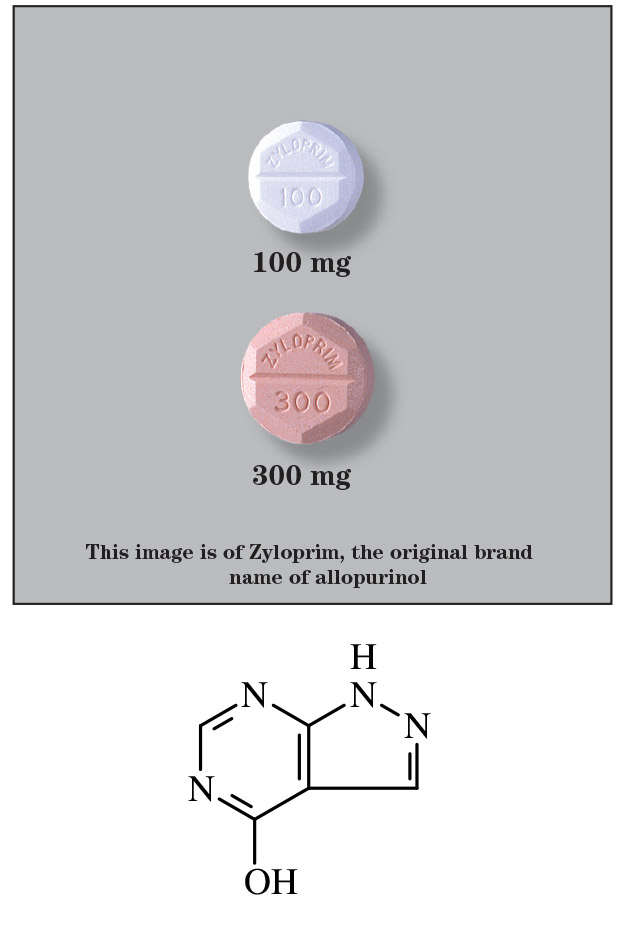
al/ō/pyūr’ i/nol
Brand Names: Zyloprim®
- Generic Available
Common Dosage Forms:
- Tablets: 100 mg and 300 mg
- Solution for injection: 500 mg in a 30 mL single dose vial
FDA Indications/Dosages:
- Treatment of gout (primary or secondary to blood dyscrasias and their therapy) and uric acid nephropathy (primary or secondary), with or without symptoms of gout:200 mg to 300 mg per day for mild gout, or 400 mg to 600 mg per day in divided doses for moderately severe tophaceous gout.
- Prevention of uric acid nephropathy in patients undergoing vigorous therapy of neoplastic disease: 600 mg to 800 mg per day for two to three days given in divided doses with a high fluid intake.
- Prevention of flare-up of acute gouty arthritis: 100 mg per day initially, followed by increases of 100 mg per week without exceeding recommended dosage until serum uric acid level is 6 mg/100 ml or less.
- Secondary hyperuricemia associated with malignancy: 300 mg per day for children 6 to 10 years of age. Children under 6 years are usually given 150 mg per day.
- Treatment of recurrent calcium oxalate stones: 200 to 300 mg per day in single or divided doses. Dosage may be adjusted according to 24 hour urinary urate readings.
Pharmacology/Pharmacokinetics:
Allopurinol competitively inhibits xanthine oxidase which is the enzyme responsible for the conversion of hypoxanthine to xanthine to uric acid. Allopurinol is metabolized to alloxanthine which also inhibits xanthine oxidase. Peak plasma levels for allopurinol and alloxanthine are reached in 1.5 hours and 4.5 hours, respec- tively, following a single oral dose. Plasma half- life of allopurinol is 1-2 hours and 15 hours for alloxanthine.
Drug Interactions:
May increase ampicillin-induced skin rash. Increases the pharmacological and toxic effects of orally administered thiopurines (mercaptop- urine and azathioprine) and chlorpropamide.
Contraindications/Precautions:
Use with caution in patients with impaired renal or hepatic function. Gout attacks may increase during initiation of therapy. Use colchicine or NSAIDs prophylactically. A sufficient fluid intake (to yield a urine output of 2 liters per day) and the maintenance of a neutral to slightly alka- line urine are recommended to avoid the forma- tion of xanthine calculi and to help prevent renal precipitation of urates in patients receiving concomitant uricosuric agents. Decrease dosage interval to once to twice a week in patients with severe renal insufficiency. Pregnancy Category C.
Adverse Effects:
Drowsiness, diarrhea, nausea, vomiting, abdominal pain, and RASH (including Stevens-Johnson syndrome).
Patient Consultation:
- Compliance with therapy is essential. May take one or more weeks to reach maximum effective- ness.
- May be taken with food or milk if GI upset occurs.
- May cause drowsiness. Use caution while oper- ating machinery or when mental alertness is required.
- Avoid alcohol while taking this medication.
- High fluid intake during therapy is beneficial to help prevent kidney stone formation.
- Store in a cool, dry place away from sunlight and children.
- If a dose is missed, skip it and return to normal dosing schedule.
- Contact a physician if the above side effects are severe or persistent.